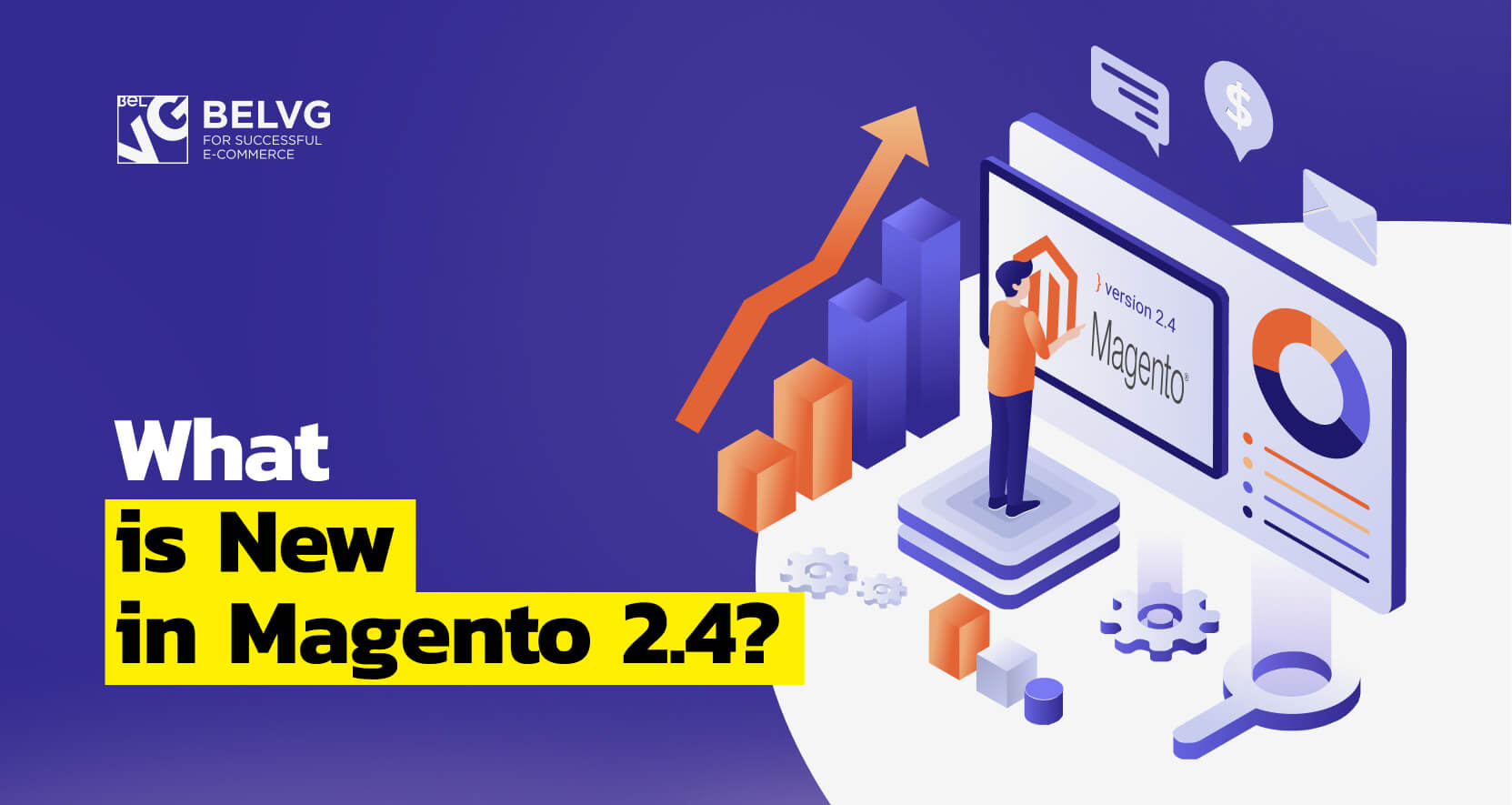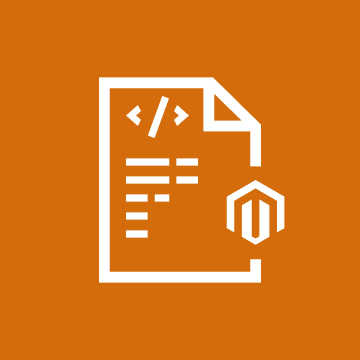
Long-awaited Magento 2.4 has been officially released on 28 July 2020. We can already discuss whether it meets the expectations of the community. Some developers claim that Magento 2.4 has become the biggest bug fixing release ever. Let’s check out the key highlights and look through the most interesting new features.
Magento 2.4 release in numbers
Magento 2.4 release: new features
Updated requirements
Security improvements
Magento 2.4 release in numbers
- Page loading speed up to 43% faster at high website traffic
- Reordering is 50% faster
- Add-to-cart performance is 30% faster during quick ordering
- 98 new features
- 50 security improvements
- 68 bugs fixed
- 12 built-in extensions
- 7 test cycles
Magento 2.4 release: new features
New media gallery
In Magento 2.4, the media gallery was completely rewritten and redesigned. It is good news as if you ever happened to use images in Magento 2, you probably noticed that this side did require improvement for a while and seemed pretty outdated. New improved interface allows searching, categorizing and filtering images much faster. This new gallery includes a seamless Adobe Stock integration v2.0 which allows you to search for necessary images without looking for third-party resources. An image preview can be opened and licensed directly in the enhanced media gallery.
However, there is also a slight downside. The Magento community developers warn that all the extensions built specifically for the media gallery are unlikely to be compatible with the new version of it. Using them in Magento 2.4 may cause unexpected issues.
Enhanced inventory management
Besides numerous bugs fixed, the version 1.2.0 of Magento inventory management introduces several nice new features.
- First of all, let’s talk about in-store pickup. It allows customers to choose a store where they want to have their products delivered. Real-time notifications inform customers once a product is ready to be picked up. In case you want to set up this function, this user guide will be useful. This new feature also provides such a gaining in popularity delivery type as curbside pickup. It is when customers can just wait in their vehicle for a product to be brought by a company’s employee.
- Two new bulk interfaces:
Magento\InventorySalesApi\Api\AreProductsSalableInterface
Magento\InventorySalesApi\Api\AreProductsSalableForRequestedQtyInterface
- Increased test coverage. Magento 2.4 provides improved software testing capabilities. The coverage for the issues that were previously discovered is extended.
- Multi source mode now supports bundle products. Previously this function used to be available only for the single source merchants. For those who ship their products from several locations, it is now easier to operate and operate larger quantities.
Seller-assisted shopping
This new feature allows an administrator to view the storefront the same way as any customer. It is a great tool for a support manager or a team to find out the problem or meet the needs of a specific customer as well as for a store owner who wants to improve overall shopping experience.
Seller-assisted shopping allows troubleshooting along the way. Let’s say a customer contacts your support because it is somehow difficult for him or her to add a product to cart or create a user account. With the new feature, it is possible to assist this customer along the way and provide help step by step. You can also explain how to use certain webstore functionality without any difficulties or even place an order on the behalf of your customer if it is necessary.
Magento B2B 1.2.0
This release cycle has added some new features to the Magento B2B extension as well as fixed some bugs there. Let’s look through the highlights:
- Purchase Order Approval Rules. It allows the administrators to control the purchase orders by creating the rules that define who can create these orders and how much they can spend.
- Magento Commerce 2.4 provides a default Login as Customer feature.
- Magento Commerce 2.4 provides access to enhanced Purchase Orders.
- Storefront order search. In the Orders section, you can now use the search bar to filter orders or search for the needed one using keywords. More information about this feature and how to use it can be found here.

Update your Magento 2 Store with BelVG
Take advantage of the newest features and boost performance
Contact usUpdated requirements
- PHP 7.4 support. It allows using typed class properties, arrow functions and other functionality. At the same time, Magento 2.4 release makes both PHP 7.1 and 7.2 deprecated. Even though PHP 7.2 is still officially supported, its End of Life is coming (November 2020) while PHP 7.1 has already reached it back in 2019.
- MySQL 8.0 support. MySQL 5.7 is still officially supported but MySQL 5.6 has already been deprecated. Even though MySQL 8.0 does not really provide new features, it is considered to highly outperform the older versions as it is more powerful and secure. It makes 8.0 a proper shoulder for Magento 2 store owners to rely on in the times of high loads.
- Elasticsearch is required for Magento 2.4. The newest release has removed MySQL from the catalog search engine and replaced it with Elasticsearch. It is one of the things you should keep in mind before upgrading your store to 2.4. You need to install and configure Elasticsearch 7.6.x. When you want to do it, here is a helpful guide.
- Support for Maria DB 10.4. Removing MySQL 5.6 support has resulted in deprecating the versions 10.0 and 10.1 of MariaDB as well. In the new Magento release, it is still possible to deploy MariaDB 10.2. However as the 10.4 version significantly outperforms its predecessor, we highly recommend to upgrade.
- Removal of the core Braintree module from the code base. The same functionality can be now gained from the Braintree Payments module. It provides support for credit card payments, Venmo, PayPal, Apple Pay, and more. The module can be downloaded here.
- Controllers decomposition. This solution reduces the pressure on performance when creating classes which are not used by the Controller. So it means that extension creators no longer have to extend from a class to build a proper action controller. A new Controller action can be installed by implementing the
\Magento\Framework\App\ActionInterface.
Security improvements
Magento claims that the new release contains over 50 security enhancements in total, including fixing vulnerabilities caused by cross-site scripting and remote code execution. For example, the template filter strict mode has been enabled by default to address the above issue. We are going to overview the most notable changes.
- Two-factor authentication (2FA) by default in the Magento Admin. Using UI or a web API, the webstore administrators have to set up this function before accessing the Admin itself. 2FA is a widely used data-protection feature but some people find it inconvenient as now it takes a bit longer to log in. On the other hand, the core idea behind this feature is to prevent data breaches and ensure that no one will access the Admin without authorization. On Magento 2.4, the 2FA cannot be disabled from the Admin but some third-party developers have already presented modules that can help you disable this feature if necessary.
- Two-factor authentication (2FA) for Magento.com user accounts. Now, besides the regular username and password that you specify while signing up, you will also receive a special randomly-generated verification code on the device that you sync to the account. For this purpose, you can use one of these free options: Google Authenticator, Authy, Microsoft Authenticator. Here you can get a full instruction on how to set up a 2FA for your Magento account.
- Multi-factor authentication (MFA) for Cloud SSH. The difference between 2FA and MFA is that the first one usually uses only knowledge authentication factor (password or secret word) and possession factor (personal device of the user – security token). Multi-factor authentication asks for more than that. It typically also requires the so-called inherence factor (biometrics recognition, for example, face, voice or fingerprint). MFA is disabled by default but Magento recommends enabling it to ensure the security of the Cloud environment. Here you can learn how to enable MFA for SSH access in Magento Commerce Cloud.
- Data rendering for UI data providers has been disabled by default. This measure prevents arbitrary JS from unauthorized execution.
- New security.txt file is now supported. It is a standard file that contains website security data, allows defining security policies and helps to inform website administrators about security holes.
The new Magento 2.4 release is one of the topics at the Adobe Commerce Summer Camp 2020. A German online event that provides several free Magento webinars and a huge discussion on the topic of digital experience shifting. If you are interested, make sure to check it out.



